
What is Enterprise Planning? Definition, Benefits and Process
By Paul VanZandt
Published on: July 26, 2023

Table of Contents
What is Enterprise Planning?
Benefits of enterprise planning, enterprise planning process: 5 key steps.
Enterprise planning is defined as the process of setting company policies, processes, and budget requirements that aim to meet the set objectives and goals of the larger strategic plan of the company. It takes into consideration all internal and external factors that affect or can potentially affect the business.
Enterprise planning is typically done for a financial year with annual revisions to accommodate the needs of the next business calendar. It is a management-level process by which the company’s leadership comes together, often led by the chief executive officer (CEO), to lay out the execution plan for the strategic vision of the company. This includes:
– Budgeting for human resources, technologies, and infrastructure.
– Balance sheet management including debt, profit margins, and product pricing.
– Setting the policies and frameworks taking into account laws and legal factors.
– Setting the processes to enable team collaboration to execute the enterprise plan.
– Ensuring teams are enabled with the right tools to do their jobs.
While enterprise planning is a critical tool for large businesses, the process allows any company or even non-profit to take advantage of its benefits of application. Here are some of the key benefits that make enterprise planning so important for any organization:
- Adds to management confidence in achieving the strategic goals
A properly thought-through enterprise plan leads to increased confidence in the management’s ability to execute the strategic plan of the company, which means the ability to achieve its core objectives. Without a thoroughly laid out plan, the strategic vision for the company is just words. It is the enterprise plan that maps the strategic goals down to the execution which will lead to the accomplishment of the goal.
- Improves employee-leadership relations
Employees are encouraged by transparency, inclusiveness, and the ability to understand the larger vision of what the company is trying to achieve. An enterprise plan takes its vision and lays it out as targets and collaborative goals among the wider teams. This way, employees have clarity on what they are doing and the expected outcome of their efforts. Such a plan is also egalitarian, since all employees, including the management, are bound by the same goals, plan, and rules.
- Builds a strong foundation for roadmaps
Roadmaps, be it for customer experience , product development, marketing, or any department/ team- are highly dependent on the underlying company structures and frameworks. For example, if an enterprise plan accurately lays out the chain-of-command for product development and how product managers can executive (executive?) whilst working with other teams for design, content, UI/UX, etc., then the product managers can accurately and confidently lay out a product roadmap. Without the supporting foundation brought about by the policies and protocols of the enterprise plan, teams may often run into conflicts with each other, have issues with technologies that are to be approved for purchase, make recruitments without going through proper approvals etc.
- Sets structured enterprise processes
A structured enterprise process is one that takes into account the various issues and challenges that may arise when employees and teams are working with each other, planning to add team members, purchasing technologies, prioritizing the right tasks, etc. In other words, an enterprise plan needs to set processes that make communication and delivery easier for employees with minimal roadblocks to deal with on the go.
For example, if it is laid out in the enterprise plan as to how the design team should prioritize and process requests coming from multiple teams, it becomes a lot easier to make decisions without conflicts and deliver outcomes faster- for all teams involved.
- Enables calibrated delegation of authority
An enterprise plan helps define roles and their scope as clearly as possible to ensure minimal role conflicts and overlaps while allowing for ample room to collaborate and work together. Delegation of authority needs to be such that it reflects the general hierarchy in the enterprise plan while defining processes on how to make changes and additions.
Authority delegation can be laid out quite precisely at a higher level, but as we move down the ladder, this delegation is much more dynamic in a given financial year. An employee who has performed better in the previous months may get added responsibilities and authority without waiting for the annual promotion cycle. How such delegations are to be worked into the larger org chart, access controls, team clarity on updated roles and how it affects their work etc. need to be laid out in the processes derived from the enterprise plan.
- Minimizes siloed operations
As teams get larger, one of the biggest issues to teamwork is siloed operations , in other words, a lack of communication and proper collaboration. There may be tasks assigned that are outdated and do not reflect recent updates, there may even be tasks on employees that no longer need to be done or are simply not a priority. These issues arise when employees are working in their own small silos, disconnected from relevant updates and information.
An enterprise plan that trickles down with the team tasks being in turn tied to the larger team goals ensures that employees do not feel siloed off, especially in remote working environments.
Learn more: What is Tactical Planning?
Here are the 5 key steps to create an enterprise plan:
1. Create a strategic plan for the business
An enterprise plan is a working plan that is derived from the larger strategic plan of the company. A strategic plan, unlike the enterprise plan, is the overarching goals and objectives of the company. Enterprise planning is the next step that seems to frame the policies, processes, and protocols to achieve the strategic plan.
F or example, if one of the strategic objectives is to grow profit by 10% annually for the next 3 years, then the annual enterprise plan must derive exactly how much more sales and upselling would need to be done, how marketing demand generation will operate to supply ample sales-ready leads and so on.
2. Invest in market research for external factors
For medium-to-large scale businesses, investment in market research to fuel the enterprise plan may be a worthy and dependable decision. Market research may be primary or secondary, depending on budget. Such a report will ensure that when judging external factors and their impact, management decisions in the enterprise plan were soundly based on data and not simply daily news and speculation.
The PESTEL method is a great guideline for doing research on external factors that are abbreviated in the term itself – political, economic, social, technological, environmental and legal.
3. Analyze internal factors
Depending on the size of the business, the management can use several tools to assess internal factors such as OKRs (for team performance evaluation and management), SWOT Analysis for identifying strengths, weaknesses, opportunities, and internal threats (such as weak cyber security protocols), BCG matrix for product/ vertical prioritization, cost-benefit analysis for new purchases and investments, etc. This is a methodical approach to understanding challenges, assessing internal issues, and coming up with the right type of solutions.
The results from these models should provide ample information about the internal state of the business and enable the leadership team to make data-backed decisions.
4. Formulate the final enterprise plan
Once all internal and external factors have been taken into account, the enterprise plan must be formulated to include solid processes, guidelines, protocols, technologies, and governance. This final document will be the framework based on how a product or service will be developed, managed, sold, and serviced to meet financial objectives. Furthermore, the enterprise plan must entail HR policy guidelines that should help me employee targets on retention and satisfaction.
5. Re-evaluate based on feedback
In an enterprise plan, there are larger company goals and then there are individual team targets and metrics that help meet the larger goals. The teams need to know what the larger goal is and what their team goals are, not necessarily the entire company’s targets and metrics. These team targets must be discussed with the team leaders and employees to whom they are concerned, before sealing them. This must take place in a time-bound manner such that there is ample room to re-evaluate and make adjustments if that is the decision.
Learn more: What is Strategic Planning?
Igniting Innovation
Powerful innovation starts as an idea. Launch your IdeaScale community today
Most Recent Posts
Explore the latest innovation insights and trends with our recent blog posts.
Crafting a Bridge to Digital Success: The Digital Business Transformation Canvas

Who is More Creative – Men or Women? 753 Studies have the Answer

Thoughts and Key Takeaways After 1.5 Years Using AI in Problem Solving

Navigating the AI Agent Frontier: Opportunities and Risks

AI Takes Center Stage at Rutgers Business School with Google Partnership

2025’s Top CIO Priorities: Staying Secure, Smart, and Inclusive

From Chaos to Clarity: The Power of Structured Idea Management

Why Curiosity is Your Agency’s Secret Weapon

The Future of Innovation: Why Collaborative Tools Are Non-Negotiable

How Covington, Kentucky is Pioneering Artificial Intelligence on a Budget

Mississippi State University Empowers High School Students to Create AI Solutions

Thinking together is the ultimate core competency
Ignite innovation with your ideascale community.
IdeaScale is an innovation management solution that inspires people to take action on their ideas. Your community’s ideas can change lives, your business and the world. Connect to the ideas that matter and start co-creating the future.
Copyright © 2024 IdeaScale
Privacy Overview
- Skip to content
- Accessibility Policy
- QUICK LINKS
- Oracle Cloud Infrastructure
- Oracle Fusion Cloud Applications
- Oracle Database
- Download Java
- Careers at Oracle
- Create an Account
- Applications
What is ERP?
See the industry-leading enterprise resource planning (ERP) cloud solution, serving as your integrated management of business processes and applications, to gain resilience and real-time agility, to position yourself for growth.
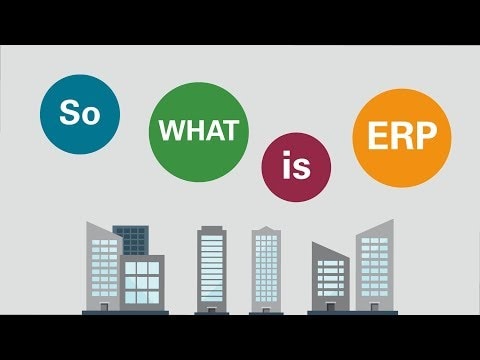
Enterprise resource planning—Overview
Definition of enterprise resource planning (erp), what is an erp system, what’s the difference between erp and financials, erp fundamentals, the business value of erp, a brief history of erp, erp deployment models: from on-premises to the cloud, cloud erp—a new erp delivery model, 7 reasons to move to an erp cloud solution.
- Get started with ERP
Enterprise resource planning (ERP) refers to a type of software that organizations use to manage day-to-day business activities such as accounting , procurement , project management , risk management and compliance , and supply chain operations . A complete ERP suite also includes enterprise performance management , software that helps plan, budget, predict, and report on an organization’s financial results.
ERP systems tie together a multitude of business processes and enable the flow of data between them. By collecting an organization’s shared transactional data from multiple sources, ERP systems eliminate data duplication and provide data integrity with a single source of truth.
Today, ERP systems are critical for managing thousands of businesses of all sizes and in all industries. To these companies, ERP is as indispensable as the electricity that keeps the lights on.
How can these solutions manage organizations day-to-day business activities, such as accounting, finance, procurement, project management, supply chain, and manufacturing.
Enterprise resource planning systems are complete, integrated platforms, either on-premises or in the cloud, managing all aspects of a production-based or distribution business. Furthermore, ERP systems support all aspects of financial management, human resources, supply chain management, and manufacturing with your core accounting function.
ERP systems will also provide transparency into your complete business process by tracking all aspects of production, logistics, and financials. These integrated systems act as a business's central hub for end-to-end workflow and data, allowing a variety of departments to access.
ERP Systems and software support multiple functions across the enterprise, mid-sized, or small businesses, including customizations for your industry.
Although the term “financials” is often used when describing ERP software, financials and ERP are not the same thing. Financials refers to a subset of modules within ERP .
Financials are the business functions relating to the finance department of an organization and includes modules for financial accounting, subledger accounting, accounting hub, payables and receivables, revenue management, billing, grants, expense management, project management, asset management, joint venture accounting, and collections.
Financials software uses reporting and analytical capabilities to comply with the reporting requirements of governing bodies, such as the International Financial Reporting Standards Foundation ( IFRS ), Financial Accounting Standards Board (FASB) for Generally Accepted Accounting Principles in the United States (GAAP), as well as for other countries (HGB in Germany and PCG in France, for example).
For public organizations, financials software has to be able to produce periodic financial statements for governing regulators, such as the US Securities and Exchange Commission ( SEC ) (with reports such as quarterly 10-Q and annual 10-K), European Securities and Markets Authority ( ESMA ), and others. For these types of financial reports, a narrative reporting tool is used. The person who is ultimately responsible for financials is the CFO.
While financials handles one area of the business, ERP encompasses a wide range of business processes—including financials. ERP software can include capabilities for procurement , supply chain management , inventory, manufacturing, maintenance, order management, project management, logistics, product lifecycle management, risk management , enterprise performance management (EPM), human resources/human capital management .
ERP also integrates with front-office applications to build holistic views of customers, including customer relationship management ( CRM ) solutions. Additionally, cloud-based ERP applications are often embedded with next-generation technologies, such as the internet of things (IoT), blockchain, AI, machine learning, and digital assistants. These advanced technologies deliver data and capabilities that not only enhance many traditional ERP functions; they create new opportunities for increased efficiencies, new services, and deeper insight across an enterprise. Since ERP systems are comprehensive across an enterprise, their management often involves a partnership with the CFO as well as the CIO, COO, and other key executive leaders.
Cloud-based ERP applications are often embedded with next-generation technologies, such as the internet of things ( IoT ), blockchain , AI, machine learning, and digital assistants.
ERP systems are designed around a single, defined data structure (schema) that typically has a common database. This helps ensure that the information used across the enterprise is normalized and based on common definitions and user experiences. These core constructs are then interconnected with business processes driven by workflows across business departments (e.g. finance, human resources, engineering, marketing, and operations), connecting systems and the people who use them. Simply put, ERP is the vehicle for integrating people, processes, and technologies across a modern enterprise.
See how industry analysts compare Oracle Cloud ERP against other financial management software providers.
For example: consider a company that builds cars by procuring parts and components from multiple suppliers. It could use an ERP system to track the requisition and purchase of these goods and ensure that each component across the entire procure-to-pay process uses uniform and clean data connected to enterprise workflows, business processes, reporting, and analytics.
When ERP is properly deployed at this automotive manufacturing company, a component, for example, “front brake pads,” is uniformly identified by part name, size, material, source, lot number, supplier part number, serial number, cost, and specification, along with a plethora of other descriptive and data-driven items.
Since data is the lifeblood of every modern company, ERP makes it easier to collect, organize, analyze, and distribute this information to every individual and system that needs it to best fulfill their role and responsibility.
ERP also ensures that these data fields and attributes roll up to the correct account in the company’s general ledger so that all costs are properly tracked and represented. If the front brake pads were called “front brakes” in one software system (or maybe a set of spreadsheets), “brake pads” in another, and “front pads” in a third, it would be tough for the automotive manufacturing company to figure out how much is spent annually on front brake pads, and whether it should switch suppliers or negotiate for better pricing.
A key ERP principle is the central collection of data for wide distribution. Instead of several standalone databases with an endless inventory of disconnected spreadsheets, ERP systems bring order to chaos so that all users—from the CEO to accounts payable clerks—can create, store, and use the same data derived through common processes. With a secure and centralized data repository, everyone in the organization can be confident that data is correct, up-to-date, and complete. Data integrity is assured for every task performed throughout the organization, from a quarterly financial statement to a single outstanding receivables report, without relying on error-prone spreadsheets.
Trending in modern finance
The ERP landscape has shifted with the rapid evolution of software as a service (SaaS) cloud applications. Because of the mobile platforms and decentralized workforce–work anywhere and anytime–ERP systems can no longer be tied to yesterday’s on-premises back-office applications. The next-generation, cloud-based, and modern ERP solutions support the new industry dynamics while providing the ability to reduce support time to enable organizations to respond quickly to volatile markets and industry trends.
It’s impossible to ignore the impact of ERP in today’s business world. As enterprise data and processes are corralled into ERP systems, businesses can align separate departments and improve workflows, resulting in significant bottom-line savings. Examples of specific business benefits include:
- Improved business insight from real-time information generated by reports
- Lower operational costs through streamlined business processes and best practices
- Enhanced collaboration from users sharing data in contracts, requisitions, and purchase orders
- Improved efficiency through a common user experience across many business functions and well-defined business processes
- Consistent infrastructure from the back office to the front office, with all business activities having the same look and feel
- Higher user-adoption rates from a common user experience and design
- Reduced risk through improved data integrity and financial controls
- Lower management and operational costs through uniform and integrated systems
From paper cards to mobile devices The history of ERP goes back more than 100 years. In 1913, engineer Ford Whitman Harris developed what became known as the economic order quantity (EOQ) model, a paper-based manufacturing system for production scheduling. For decades, EOQ was the standard for manufacturing. Toolmaker Black and Decker changed the game in 1964 when it became the first company to adopt a material requirements planning (MRP) solution that combined EOQ concepts with a mainframe computer.
MRP remained the manufacturing standard until manufacturing resource planning (called MRP II) was developed in 1983. MRP II featured “modules” as a key software architectural component, and integrated core manufacturing components including purchasing, bills of materials, scheduling, and contract management. For the first time, different manufacturing tasks were integrated into a common system. MRP II also provided a compelling vision of how organizations could leverage software to share and integrate enterprise data and boost operational efficiency with better production planning, reduced inventory, and less waste (scrap). As computer technology evolved through the 1970s and 1980s, concepts similar to MRP II were developed to handle business activities beyond manufacturing, incorporating finance, customer relationship management, and human resources data. By 1990, technology analysts had a name for this new category of business management software—enterprise resource planning.
ERP's past: 1990s to the new millennium From the 1990s until the beginning of the twenty-first century, ERP adoption grew rapidly . At the same time, the costs of implementing an ERP system began to climb. The hardware required to run the software was typically on company premises, with big machines in a server room. Both the hardware and the software licenses required capital investments and depreciated over 5 to 10 years. In addition, organizations nearly always wanted to customize their ERP systems to fit their specific needs, entailing an additional expense of software consultants and training.
Meanwhile, ERP technology was evolving to embrace the internet, with new features and functionality such as embedded analytics. As time went on, many organizations discovered that their on-premises ERP systems couldn’t keep up with modern security demands or emerging technologies such as smartphones.
Software-as-a-service (SaaS) Enter the cloud—specifically, the software-as-a-service (SaaS) delivery model for ERP. When ERP software is delivered as a service in the cloud, it runs on a network of remote servers instead of inside a company’s server room. The cloud provider patches, manages, and updates the software several times a year—rather than an expensive upgrade every 5 to 10 years with an on-premises system. The cloud can reduce both operational expenses (OpEx) and capital expenses (CapEx) because it eliminates the need for companies to purchase software and hardware, or hire additional IT staff. These resources can instead be invested in new business opportunities, and the organization is always up-to-date on the most recent ERP software. Employees can shift their focus from managing IT to more value-added tasks such as innovation and growth.
For businesses of all sizes, including enterprise and small to midsize , retiring on-premises systems and moving entirely to the cloud all at once isn’t possible. Or, at the very least, it’s not something they’re comfortable doing within a short development window. Meanwhile, staying the course with an on-premises ERP, ignoring all the advantages of enterprise resource planning as a cloud solution, is no longer an ideal path, either. Why should you consider using cloud applications to replace or augment your on-premises system?
1. Readily adopt new and evolving SaaS technologies
Next-generation technologies, like artificial intelligence (AI), help cloud-based systems rapidly improve their capabilities with no need for periodic updates, unlike your legacy system. Now, with no additional or new input from the end-user, ERP systems continually become significantly easier to manage and use.
2. Extend the value of your existing ERP System
Augmenting and integrating legacy software with cloud applications can complement, enhance, and supplement important tasks. This approach can breathe new life into legacy ERP systems, giving businesses a great opportunity to start adopting cloud capabilities.

3. Access new technologies
Finding cloud applications that complement your legacy ERP software modules lets you immediately take advantage of rapidly advancing new technologies and improving user paradigms. These provide complimentary systems that deliver immediate business capabilities and value without a fundamental change in your operations.
4. Reduce third-party dependencies
Reporting and analytics for legacy systems typically require involvement from a third-party vendor to generate operational business intelligence. Using cloud applications from your legacy ERP vendor often produces the same or better intelligence without needing an additional vendor relationship.
5. Evolve your financial systems
Legacy systems were never meant to be modern reporting engines. Cloud-based technology was born in the last decade and developed, as a core principle, with an entirely different mindset and understanding of not only what was possible but what was needed to be successful for ERP platforms.
6. More robust security resources
Cloud solution service providers have large, full-time teams that are exclusively dedicated to proactively monitoring and staying current with cloud security issues and threats, 24 hours a day.
7. Attract in-demand talent
The next generation of young workers have grown up with seamless technology that is mobile, easy to use, and always-on. No company that continues to rely purely with on-premises technology will be able to recruit top talent, regardless of age.
Get started with Oracle ERP
Organizations have always struggled to balance traditional ERP’s high costs and complexity against the need for customized features and flexibility, all while meeting the demands of the business. Watch and learn how Oracle ERP Cloud delivers connected teams, unified data, and real-time insights to help you and your finance team ensure that the best business decisions are made. With ERP delivered as a service in the cloud, your organization can be future-ready and outpace change.
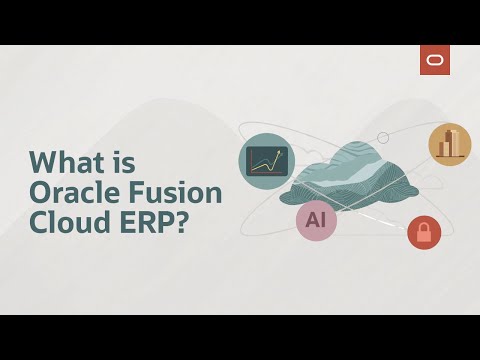
One of the benefits of the SaaS model is that the software is kept up-to-date with the latest features, functions, and best practices. Cloud ERP providers roll out updates regularly (as often as monthly, in Oracle’s case). This means that the latest new and revolutionary emerging technologies—such as AI, digital assistants, machine learning, blockchain, augmented reality, and the Internet of Things (IoT)—become available to subscribers on a regular cadence.
With access to these new technologies, organizations can quickly improve their business best practices as the ERP software evolves. They can automate processes that used to require heavy manual intervention, such as reconciling financial accounts. In addition, users gain a comprehensive, real-time understanding of enterprise business activities not only in the front office, but also in warehouses, on factory floors, and everywhere else across the enterprise. This knowledge is then readily available to every appropriate employee on their mobile devices, including smartphones and tablets.
Built for the digital age, today’s ERP cloud embraces mobile, social, analytics, and the latest emerging technologies. Anything less won’t move an organization forward.
What is ERP in simple terms? ERP stands for enterprise resource planning. It’s a software system that includes all the tools and processes required to run a successful company, including HR, manufacturing, supply chain, finance, accounting, and more.
What are the 3 common types of ERP? The three most common types of ERP are on-premises, cloud-based, and hybrid ERP. An on-premises ERP system is run on-location on a company’s servers, while cloud-based ERP operates on a third-party, remote server. Hybrid ERP is a mix of both, often with an on-premises ERP at headquarters and cloud-based ERP systems at subsidiaries.
What is an example of ERP? One example of ERP is industry-specific ERP systems that meet the specific requirements for those business types and offer industry-specific capabilities like materials planning and specialized manufacturing records management. Because these systems offer such tailored features, businesses don’t have to do too much customization or integrate with many other external tools.
Learn more about Oracle Cloud ERP
- go to walkme.com

Enterprise planning: A guide to elevating your business

Every year business planning gets more complicated. Emerging tech, complex staff needs, and significant financial pressures can make it feel like the pressure points will never end for the executive management. And in 2023, the impact of Covid-19 pandemic and the russia-ukraine war are taking their toll.
But relief is on the way. With the right strategic vision, enterprise planning holds all the answers to a well structured, successful organization. The industry is already recognizing the benefits of enterprise planning, with Gitnux reporting that the global ERP software market is likely to reach USD 100 billion by 2025 .
The global success of the enterprise planning process comes from the fact that it encompasses all the planning areas. It therefore has the outcome of an organized and successfully acquire a competitive advantage throughout this entire process.
To help you understand enterprise planning and how to plan in 2023, we will cover the following topics:
What is the purpose of enterprise planning in 2023?
What elements does enterprise planning include, what are the benefits of enterprise planning, how to implement enterprise planning in 6 steps.
The purpose of enterprise management, also called comprehensive planning or analysis planning , in 2023 is to enable you to control, balance and align your company goals via your organization’s management and capabilities and financial objectives.
You can achieve this using an Enterprise Management System (EMS), sometimes called Enterprise System.
These are software packages that support your organizations to manage several software tasks at once, completing and improving business processes, and can include ERP (enterprise resource planning) resource allocation software.
If you’d like a visual representation of the purpose of enterprise planning in 2023, click on the three-minute video below.
QueBIT – Extended Planning and Analysis (xP&A)
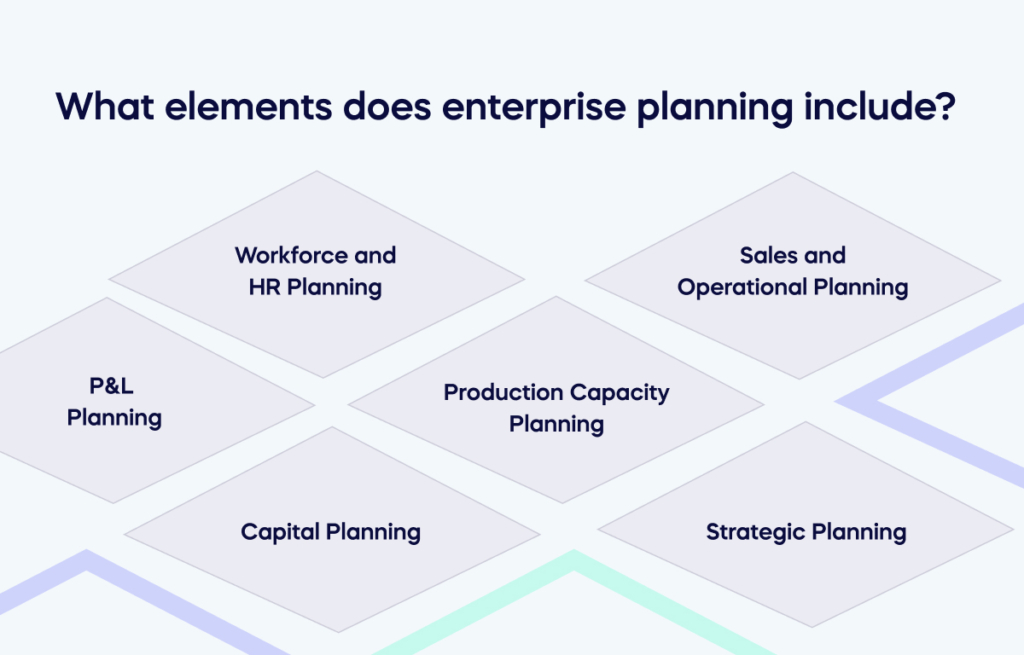
To help frame enterprise planning in the context of 2023, let’s look at its core functions via the different sub-types of planning that fall under the enterprise planning umbrella.
The first of these planning types is P&L (profit and loss) planning, as seen below:
- P&L Planning: Enterprise management should be the core of your financial planning efforts, as it involves allocating resources and how this relates to your company goals.
- Workforce and HR Planning: People are resources, and enterprise management helps you decide who is needed for which area of the organization.
- Capital Planning: Enterprise management helps you to see where you must allocate capital for the best return.
- Production Capacity Planning: Knowing the production capacity can assist you in making the most of resources, cutting costs, and detecting potential issues using market research.
- Sales and Operational Planning: S&OP (sales and operations planning) is a planning process that integrates demand, supply, and financial planning.
- Strategic Planning: Get an overarching view of your goals and the strategy to achieve them with enterprise planning.
It is helpful to be aware of the functions of enterprise planning to ensure you optimize its use within your organization.
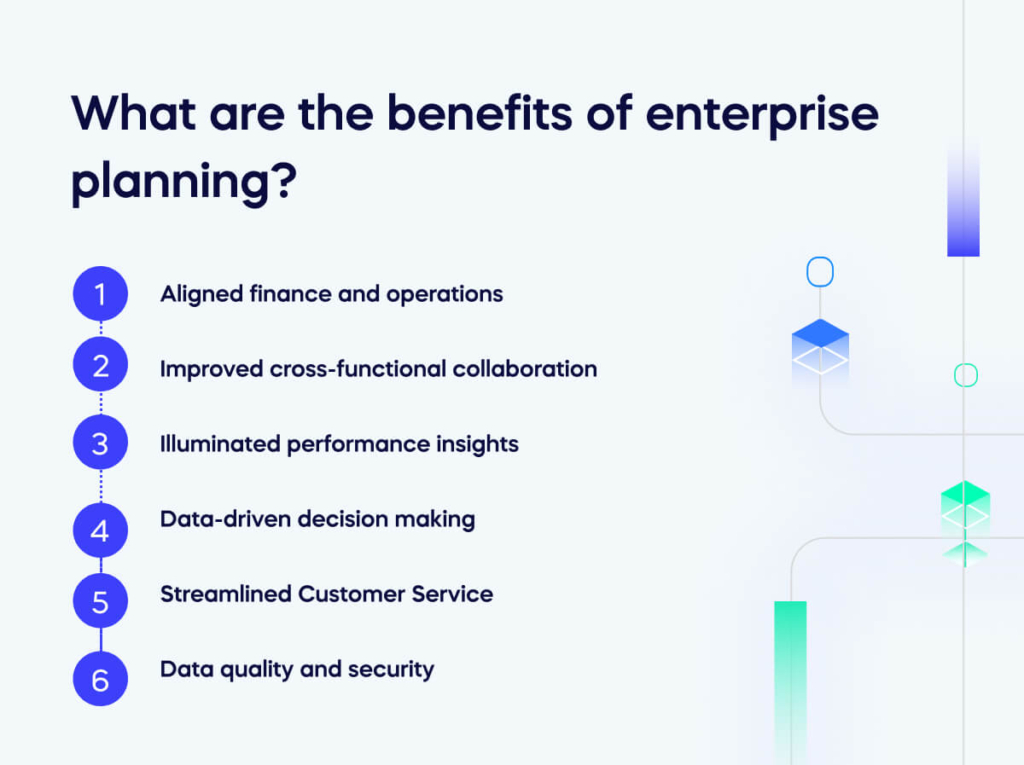
There are many benefits of enterprise planning, and being aware of them helps ensure you get the most out of any enterprise planning strategy.
Aligned finance and operations
Enterprise planning lets planners see the cause-and-effect relationship between operational and financial data. This gives planners more visibility into resource requirements to enable optimum business performance.
Improved cross-functional collaboration
When organizations plan by department, plans are typically siloed from one another. All departments plan with other departments in mind by instituting a cohesive planning process across the organization.
This awareness results in a more strategic operational approach which considers financial results and more effective performance improvement and management.
Illuminated performance insights
Many companies limit the planning function by relegating planning tools to finance and finance alone. But organizations can potentially align their entire business by deploying an enterprise planning strategy using key performance indicators (KPIs).
To get the best performance insights on training progress as your staff learn how to use enterprise planning tools, implement our DAP (digital adoption platform).
It’s in-app guidance and personalized learning can drive and illuminate performance throughout your enterprise planning strategy.
When all planning functions are connected enterprise-wide, planners from every department can determine goals and create budgets and plans that consider all facets of the organization.
Data-driven decision making
Enterprise planning systems elevate planners’ analysis by democratizing relevant information across departments.
With the ability to sift and sort enterprise data according to various drivers, planners can understand the root cause of performance, which enables them to either take action or change course.
Streamlined Customer Service
Even if your company’s clients are unaware of it, they also enjoy the advantages of the enterprise planning system.
The system centralizes and simplifies client information, freeing your sales team to focus on building and sustaining customer relationships rather than managing spreadsheets. Ultimately, customer acquisition and retention are paramount concerns for any business.
Data quality and security
Enterprise planning systems bring the advantage of improved data security since they focus on managing data and offer sharing capabilities across different departments, such as sales and marketing.
This collaboration enhances employee productivity . However, enterprise planning solutions also provide control mechanisms to ensure only authorized person access and edit the data.
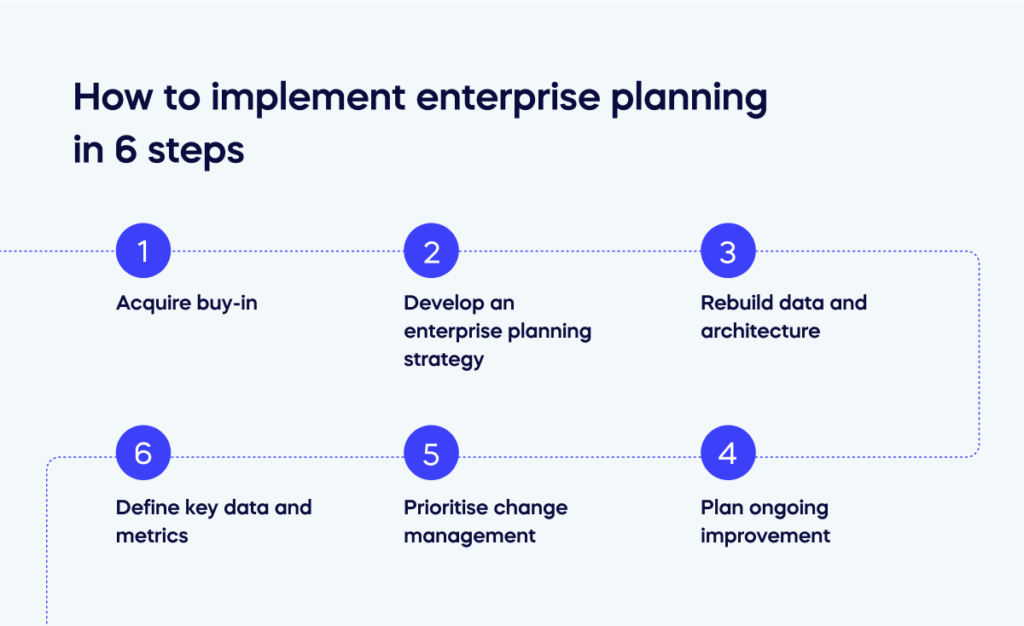
Expanding planning and analysis beyond the finance function to include planning processes, data, and tools requires careful strategies and consideration, even if it may seem like a natural progression for enterprise planning processes.
To increase the chances of successfully adopting enterprise planning across the business by including all internal and external factors, follow the steps outlined below:
1. Acquire buy-in
To implement enterprise planning, it is crucial to have backing from the executive team and departmental leaders. The finance team needs to ensure that everyone comprehends their responsibilities in these upgraded procedures and the advantages that enterprise planning can offer them.
2. Develop an enterprise planning strategy
The finance department needs to plan how to roll out FP&A to all departments in the business. Additionally, it should develop a strategy for continuous planning and performance management that considers the views of critical stakeholders.
3. Rebuild data and architecture
To fully achieve xP&A goals, simply transferring current systems may not be sufficient. Identifying what digital tools and capabilities are necessary to enable xP&A goals and ensure data integrity .
Integration of all relevant business data in one platform will require changes in architecture and increased data management requirements.
4. Define key data and metrics
The finance department can collaborate with other departments and business units to determine the most crucial operational and financial performance data, identify potential changes, and decide which metrics should be included in xP&A.
5. Prioritise change management
It’s vital for everyone involved, including executives, board members, managers, users, and the IT department, to make changes when implementing xP&A.
To ensure a successful deployment, it’s crucial to prioritize change management and clear communication throughout the process.
6. Plan ongoing improvement
Over time, xP&A processes can be improved and expanded. Organizations should consider adopting a test-and-learn approach to successfully implement xP&A in different functions, geographic locations, or business units.
Streamline your enterprise planning with a DAP
Enterprise planning is vital for businesses seeking to elevate their operations. By embracing strategic thinking, data-driven insights, and efficient decision-making, organizations can confidently navigate the complexities of a rapidly evolving market.
However, to truly unlock the full potential of enterprise planning, it’s crucial to leverage modern technologies that simplify and streamline the process. That’s where a DAP comes into play.
With its advanced features and capabilities, a DAP empowers businesses to optimize their enterprise planning projects, enabling seamless collaboration, real-time data analysis, and informed decision-making.
Don’t wait any longer; take the leap and use a DAP to streamline your enterprise planning project today. Witness firsthand the transformative impact it can have on your business’s growth and success.
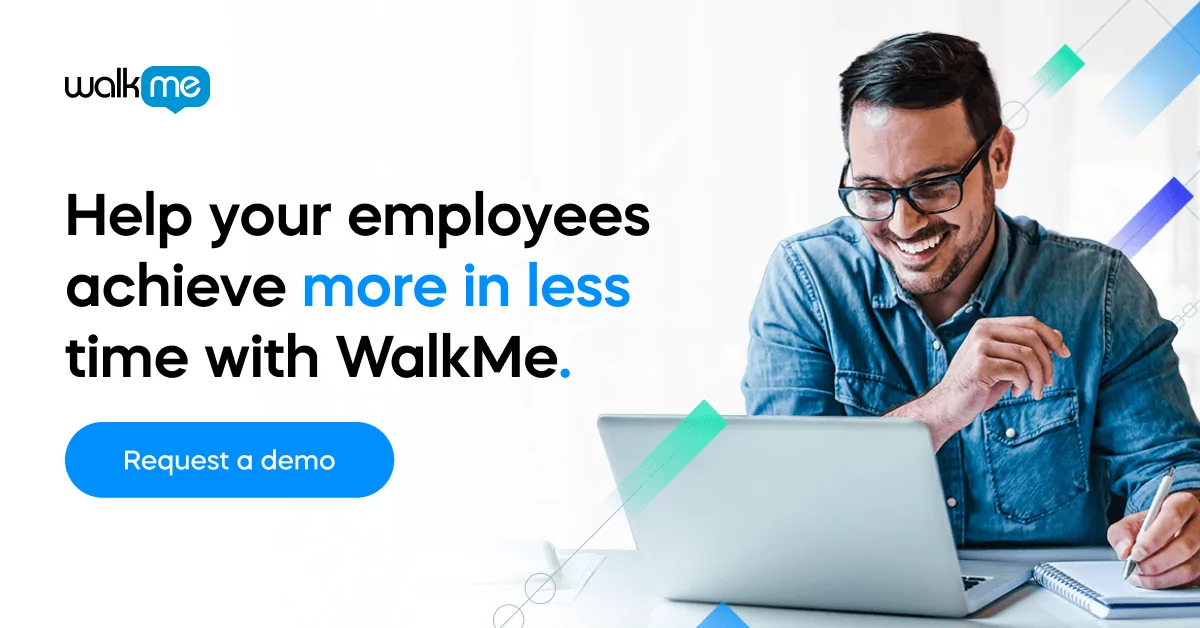
Like what you are reading?
Sign up for our weekly digest of the latest digital trends and insights delivered straight to your inbox.
By clicking the button, you agree to the Terms and Conditions . Click Here to Read WalkMe's Privacy Policy
This site is protected by reCAPTCHA and the Google Privacy Policy and Terms of Service apply.
Thanks for subscribing to WalkMe’s newsletter!

IMAGES
COMMENTS
Enterprise Business Planning (EBP) goes beyond IBP in its level of integration, adding the dimensions of marketing, pricing, and capital asset planning. As such, it completes the convergence of planning efforts across all functions: operational, finance (back office), and commercial (front office).
Jul 26, 2023 · Enterprise planning is typically done for a financial year with annual revisions to accommodate the needs of the next business calendar. It is a management-level process by which the company’s leadership comes together, often led by the chief executive officer (CEO), to lay out the execution plan for the strategic vision of the company.
Enterprise business planning | Taking your company’s planning capabilities to the ultimate level 2 Technology-enabled business planning is an essential capability that has improved by leaps and bounds since it first emerged in the early 1960s. Systematic integration efforts under the banner of Sales and Operations Planning and Integrated Business
Enterprise resource planning systems are complete, integrated platforms, either on-premises or in the cloud, managing all aspects of a production-based or distribution business. Furthermore, ERP systems support all aspects of financial management, human resources, supply chain management, and manufacturing with your core accounting function.
Discover how organizations can move to a more connected, insights-driven process called enterprise business planning (EBP). Impacts of the digital finance journey on FP&A. T he financial planning and analysis (FP&A) function has a mandate to evolve its role as a strategic value partner. Leaders are leveraging the explosive trends in digital ...
Nov 10, 2023 · Learn what enterprise planning is, what it includes, and how to implement it in 2023. Enterprise planning is a strategic process that aligns your company goals, resources, and financial objectives across different functions and departments.